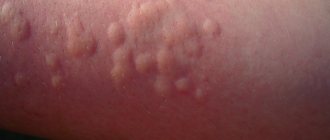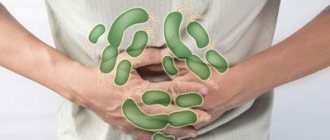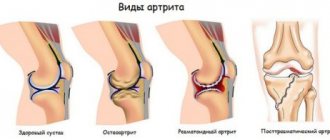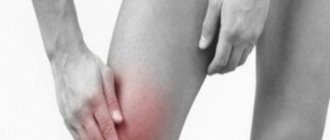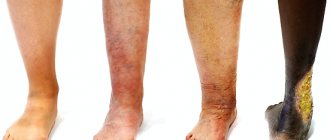Causes and mechanisms of development of traumatic shock
The common everyday expression is “pain shock”, “death from pain shock”. The true cause of the development of traumatic shock is the rapid loss of a large volume of blood or plasma. Moreover, this loss does not have to be in the form of obvious (external) or hidden (internal) bleeding - a shock state can also be caused by massive exudation of plasma through the burned surface of the skin during burns.
What is important for the development of traumatic shock is not so much the absolute amount of blood loss as the rate of blood loss. With rapid blood loss, the body has less time to adjust and adjust, and shock is more likely to develop. Therefore, shock is more likely when large arteries, such as the femoral artery, are injured.
Severe pain, as well as neuropsychic stress associated with injury, undoubtedly play a role in the development of the shock state (although they are not its main cause) and aggravate the severity of shock.
Factors leading to the development of traumatic shock or aggravating it are also injuries with damage to particularly sensitive areas (perineum, neck) and vital organs (for example, a wound to the chest, rib fractures with impaired external respiration function, traumatic brain injury). In such cases, the severity of shock is determined by the amount of blood loss, the intensity of the pain syndrome, the nature of the injury and the degree of preservation of the function of vital organs.
Rapid and massive blood or plasma loss leads to a sharp decrease in the volume of circulating blood in the victim’s body. As a result, the victim’s blood pressure quickly and severely drops, the supply of tissue with oxygen and nutrients deteriorates, and tissue hypoxia develops. Due to the lack of oxygen in the tissues, toxic under-oxidized metabolic products accumulate in them, metabolic acidosis develops, and intoxication increases. Lack of glucose and other nutrients in tissues leads to their transition to “self-sufficiency” - lipolysis (fat breakdown) and protein catabolism increase.
The body, trying to cope with blood loss and stabilize blood pressure, reacts by releasing various vasoconstrictor substances into the blood (in particular, adrenaline, norepinephrine, dopamine, cortisol) and spasm of peripheral vessels. This may temporarily stabilize blood pressure at a relatively “acceptable” level, but at the same time further worsens the situation with the supply of oxygen and nutrients to peripheral tissues. Accordingly, metabolic acidosis, intoxication with under-oxidized metabolic products, and catabolic processes in tissues intensify even more. Centralization of blood circulation occurs - the brain, heart, and lungs are primarily supplied with blood, while the skin, muscles, and abdominal organs do not receive enough blood. Lack of blood supply to the kidneys leads to a decrease in glomerular filtration of urine and a deterioration in the excretory function of the kidneys, up to complete anuria (lack of urine).
Spasm of peripheral vessels and increased blood clotting as a reaction to bleeding contribute to the blockage of small spasmodic vessels (primarily capillaries) with tiny blood clots - blood clots. The so-called “DIC syndrome” develops - disseminated intravascular coagulation syndrome. Blockage of small vessels further increases problems with blood supply to peripheral tissues and, in particular, the kidneys. This leads to a further increase in metabolic acidosis and intoxication. The so-called “consumption coagulopathy” may develop - a blood clotting disorder due to the massive consumption of clotting agents in the process of widespread intravascular coagulation. In this case, pathological bleeding may develop or bleeding from the injury site may resume, and further worsening of shock may occur.
A decrease in blood supply to the adrenal glands and their function against the background of an increased need for glucocorticoids in “shock” tissues leads to a paradoxical situation. Despite the high level of cortisol in the blood (spike!), there is relative adrenal insufficiency. This is explained by the fact that less is “thrown away” than the tissues need, and the poorly supplied adrenal glands are physically unable to produce more cortisol.
The body's attempts to cope with pain by increasing the secretion of endorphins (endogenous analogues of opiates) lead to a further drop in blood pressure, the development of lethargy, lethargy, and anergy. The reaction to a decrease in blood pressure and a high level of catecholamines in the blood is tachycardia (rapid heartbeat). At the same time, due to insufficient circulating blood volume, cardiac output (stroke volume of the heart) is simultaneously reduced and there is weak filling of the pulse (up to a thread-like or undetectable pulse in the peripheral arteries).
Severe shock without treatment usually results in agony and death. In the case of a relatively mild or moderate shock, self-healing is in principle possible (at some stage, further development of the shock may stop, and then the condition will stabilize, the body will adapt and recovery will begin). But this cannot be relied upon, since the development of a shock state of any degree in itself indicates a failure of adaptation, that the severity of the injury has exceeded the compensatory capabilities of this particular organism.
Shock can be primary (early), which occurs immediately after injury and is an immediate reaction to injury. Secondary (late) shock occurs 4-24 hours after the injury and even later, often as a result of additional traumatization of the victim (during transportation, cooling, renewed bleeding, tightening a limb with a tourniquet, from rough manipulations during the provision of medical care, etc.). A common type of secondary shock is postoperative shock in the wounded. Under the influence of additional trauma, relapses of shock in victims are also possible, usually within 24-36 hours. Shock often develops after the tourniquet is removed from the limb.
What not to do?
- If there are foreign objects in the wound, they should not be touched. Washing the wound and antiseptic measures are allowed.
- The patient is allowed to move only from places where he may be in danger (highway, railway tracks).
- Giving analgesics to a person with low body temperature and massive blood loss is prohibited. There may be a decrease in pressure and an acceleration of the transition from one stage of shock to another.
- It is also unacceptable to give the victim any medications during first aid, as they can alleviate the symptoms.
Do not forget that when shock occurs, survival rate drops. Sometimes the stages change quickly, and saving a person becomes much more difficult. After finding the victim, immediately call an ambulance and use all possible rescue methods.
Traumatic shock
- a life-threatening serious condition that occurs as a reaction to an acute injury, which is accompanied by large blood loss and intense pain. Shock appears at the moment of receiving a traumatic effect in case of pelvic fractures, gunshot, traumatic brain injuries, severe damage to internal organs, in all cases associated with large loss of blood.
Traumatic shock is considered a companion to all severe injuries, regardless of their causes. Sometimes it can occur after some time due to additional trauma. In any case, traumatic shock is a very dangerous phenomenon, posing a threat to human life, requiring immediate recovery in intensive care.
Symptoms of shock
Traumatic shock usually goes through two phases in its development, the so-called “erectile” phase of shock and the “torpid” phase. In patients with low compensatory capabilities of the body, the erectile phase of shock may be absent or very short (measured in minutes) and shock begins to develop immediately from the torpid phase, for example, with a very severe injury or wound (traumatic avulsions and crushing of the limbs at the hip level, penetrating wounds of the abdominal and chest cavity with injury to internal organs, severe traumatic brain injury), accompanied by blood loss and crushing of soft tissues. Such injuries usually result in shock of extreme severity. In this case, the person immediately loses consciousness due to an excessively strong pain signal, which the brain is simply unable to cope with and, as it were, “turns off.”
Erectile shock phase
At the initial stage, the victim feels pain and signals it using the means available to him: screaming, moaning, words, facial expressions, gestures. In the first, erectile, phase of shock, the patient is excited, scared, and anxious. Often aggressive. Resists examination and treatment attempts. He may thrash about, scream in pain, moan, cry, complain of pain, ask or demand analgesics, drugs.
In this phase, the body’s compensatory capabilities have not yet been exhausted, and blood pressure is often even higher than normal (as a reaction to pain and stress). At the same time, there is a spasm of skin vessels - pallor, which intensifies as bleeding continues and/or shock progresses. There is a rapid heartbeat (tachycardia), rapid breathing (tachypnea), fear of death, cold clammy sweat (such sweat is usually odorless), tremors (shaking) or small muscle twitches. The pupils are dilated (reaction to pain), the eyes are shiny. The look is restless, does not stop at anything. Body temperature may be slightly elevated (37-38 C) even in the absence of signs of wound infection - simply as a result of stress, the release of catecholamines and increased basal metabolism. The pulse remains satisfactory and rhythmic. There are no signs of development of disseminated intravascular coagulation syndrome, shock kidney syndrome, or shock lung syndrome. The skin is usually cold (vasospasm).
Torpid phase of shock
In this phase, the patient in most cases stops screaming, moaning, crying, thrashing about in pain, does not ask for anything, does not demand anything. He is lethargic, lethargic, apathetic, drowsy, depressed, and may lie in complete prostration or lose consciousness. Sometimes the victim may only make a faint moan. This behavior is caused by a state of shock. However, the pain does not decrease. Blood pressure decreases, sometimes to critically low numbers or is not determined at all when measured in peripheral vessels. Severe tachycardia. Pain sensitivity is absent or sharply reduced. He does not respond to any manipulation in the wound area. He either doesn’t answer questions or answers barely audibly. Convulsions may occur. Involuntary release of urine and feces often occurs.
The eyes of a patient with torpid shock dim, lose their shine, look sunken, and shadows appear under the eyes. The pupils are dilated. The gaze is motionless and directed into the distance. Body temperature can be normal, increased (wound infection) or slightly decreased to 35.0-36.0 ° C (“energy depletion” of tissues), chills even in the warm season. Noteworthy is the sharp pallor of the patients, the cyanosis (cyanotic) of the lips and other mucous membranes. Low levels of hemoglobin, hematocrit and red blood cells in the blood.
Intoxication phenomena are noted: lips are dry, parched, the tongue is heavily coated, the patient is tormented by constant strong thirst and nausea. Vomiting may occur, which is a poor prognostic sign. The development of “shock kidney” syndrome is observed - despite thirst and drinking plenty of fluids for it, the patient has little urine and it is highly concentrated and dark. In severe shock, the patient may not have any urine at all. “Shock lung” syndrome - despite rapid breathing and intense work of the lungs, the supply of oxygen to tissues remains ineffective due to vasospasm and low levels of hemoglobin in the blood.
The skin of a patient with torpid shock is cold, dry (there is no longer cold sweat - there is nothing to sweat with due to the large loss of fluid during bleeding), tissue turgor (elasticity) is reduced. Sharpening facial features, smoothing nasolabial folds. The saphenous veins are collapsed. Pulse is thread-like, more than 120 per minute
. The faster and weaker the pulse, the more severe the shock.
There are liver dysfunctions (since the liver also does not receive enough blood and experiences oxygen starvation). If a patient with traumatic shock survives, then after a few days a (usually mild) jaundice of the skin may appear as a result of increased bilirubin levels in the blood and impaired bilirubin-binding function of the liver.
Classification and degrees
Depending on the cause of the injury, types of traumatic shock are classified as:
- Surgical;
- Endotoxin;
- Shock resulting from a burn;
- Shock resulting from fragmentation;
- Shock from the impact of the shock wave;
- Shock received when applying a tourniquet.
According to the classification of V.K. Kulagin there are such types of traumatic shock:
- Operating;
- Wound (appears as a result of mechanical action, can be visceral, cerebral, pulmonary, occurs with multiple injuries, sudden compression of soft tissues);
- Mixed traumatic;
- Hemorrhagic (develops as a result of bleeding of any nature).
Regardless of the causes of shock, it goes through two phases - erectile (excitation) and torpid (inhibition).
- Eriktilnaya.
This phase occurs at the moment of traumatic impact on a person with a sudden sharp excitation of the nervous system, manifested in excitement, anxiety, and fear.
The victim remains conscious, but underestimates the complexity of his situation. He can answer questions adequately, but has impaired orientation in space and time.
The phase is characterized by pale human skin, rapid breathing, and severe tachycardia.
Mobilization stress in this phase varies in duration; shock can last from several minutes to hours. Moreover, with severe trauma, it sometimes does not manifest itself in any way.
And too short an erectile phase often precedes a more severe course of shock in the future.
- Torpid phase.
Accompanied by a certain inhibition due to inhibition of the activity of the main organs (nervous system, heart, kidneys, lungs, liver).
Circulatory failure increases. The victim becomes pale. His skin has a gray tint, sometimes a marble pattern, indicating poor blood supply, stagnation in the blood vessels, and he breaks out in cold sweat.
The limbs in the torpid phase become cold, and breathing becomes rapid and shallow.
The torpid phase is characterized by 4 degrees, which indicate the severity of the condition.
- First degree.
Considered easy. In this condition, the victim has a clear consciousness, pale skin, shortness of breath, slight lethargy, the pulse reaches 100 beats/min, the pressure in the arteries is 90-100 mm Hg. Art.
- Second degree.
This is a moderate shock. It is characterized by a decrease in pressure to 80 mm Hg. Art., pulse reaches 140 beats/min. The person has severe lethargy, lethargy, and shallow breathing.
- Third degree.
An extremely serious condition of a person in shock, who is in a confused state of consciousness or has completely lost it.
The skin becomes earthy gray in color, and the fingertips, nose and lips become bluish. The pulse becomes thread-like and increases to 160 beats/min. The man is covered in sticky sweat.
- Fourth degree.
The victim is in agony. Shock of this degree is characterized by a complete absence of pulse and consciousness.
The pulse is barely palpable or completely imperceptible. The skin is gray in color, and the lips become bluish and do not respond to pain.
The prognosis is most often unfavorable. The pressure becomes less than 50 mm Hg. Art.
Treatment of traumatic shock
First aid for shock
The main first aid measure for traumatic shock is to stop bleeding. When the air temperature is low, it is also worth covering the victim to prevent hypothermia. It is necessary to ensure the prompt provision of qualified medical care to the victim by calling an ambulance or taking the victim to a medical facility. If the victim has no injuries or injuries, use an anti-shock position: the victim lies on his back, legs raised 15-30 cm[1].
Providing emergency assistance
Regardless of the degree of shock, the effect of assistance depends on how quickly it is provided. Help should be directed
- to eliminate traumatic causes,
- to relieve or reduce pain,
- to stop bleeding,
- for activities aimed at improving respiratory and cardiac activity (resuscitation measures),
- to prevent general cooling.
At the same time, they ask someone to call the rescue services.
Providing assistance if the patient is conscious
Reducing pain is achieved by placing the body in a position where the conditions for increased pain are reduced. For bone fractures, reliable immobilization of the damaged body parts is necessary.
Painkillers are given before the ambulance arrives. If they are absent, you can give a little drink (20-30 ml) of vodka or alcohol.
Treatment for shock will be ineffective if bleeding continues. Therefore, it is necessary to stop the bleeding as quickly as possible. To do this, apply a tourniquet above the bleeding site or a pressure bandage.
- reduce pain,
- give fluids to drink,
- create peace and quiet around the victim,
- transport carefully to hospital.
Important: create an atmosphere of psychological calm, it is necessary to reassure him, instill confidence in a favorable outcome of events.
Pathogenesis: compensation phase
As noted above, with the development of this type of shock, the trigger mechanism is injury. Trauma accompanied by severe pain or excessive blood loss causes stress reserves to be activated. The main such reserves are two body systems:
The sympatho-adrenal system causes the endocrine glands (mainly the adrenal glands) to release specific stress hormones into the blood: adrenaline, norepinephrine, corticosteroids. These biologically active substances directly affect the vascular wall, causing spasm and constriction of peripheral vessels. They are found in the skin, muscles, kidneys, liver, lungs, etc. In addition, this system helps speed up the heartbeat for more active blood circulation through the vessels.
When blood loss is great, blood supply to all internal organs, including the kidneys, deteriorates. It is then, under conditions of renal ischemia, that the renin-angiotensin-aldosterone system is activated, which also provokes vascular spasm. This is achieved both by the direct activity of angiotensin and by its activation of aldosterone, which also has a vasoconstrictor effect.
Generalized narrowing of peripheral vessels leads to a disorder of microcirculation, that is, blood circulation of internal organs. However, our body is not stupid. By constricting blood vessels in the periphery, it increases blood supply to the most important human organs: the heart, brain and adrenal glands. The phenomenon of “centralization of blood circulation” occurs.
What is shock like after an injury?
Traumatic shock after an injury can be classified as:
- Painful shock after complete or partial crushing of the bone;
- Unbearable pain after receiving an extensive burn;
- Pain after surgery;
- Traumatic shock as a result of an attempt to stop profuse bleeding by applying a tourniquet;
- A knife strike to soft tissues - neck, abdominal cavity, arms, legs, head.



